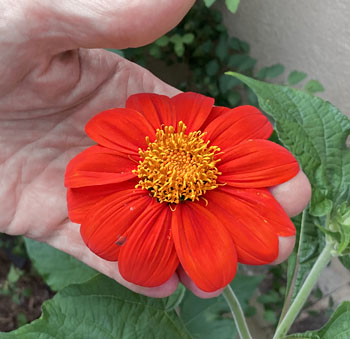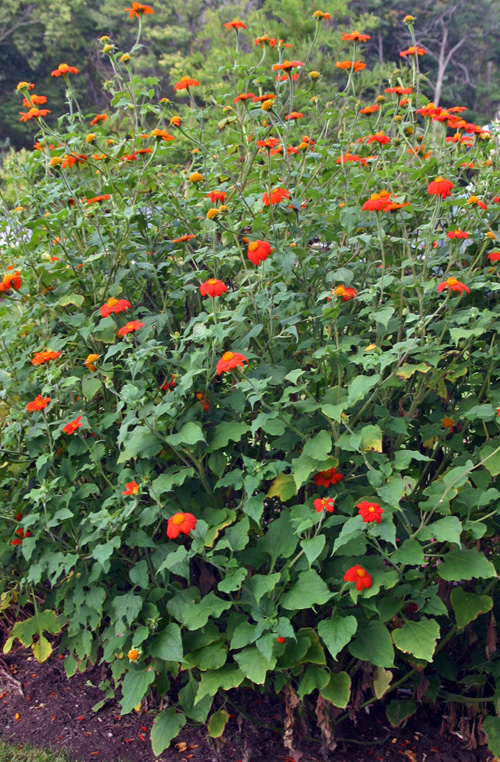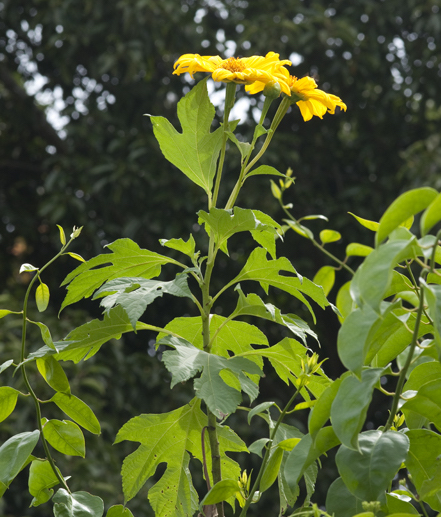The Native Mexican Sunflower
By Ray Novitske, Fairfax Master Gardener

Tithonia rotundifolia
Tithonia, also known as a Mexican sunflower, sounds more like a city in Michigan or an eastern European country than a native Mexican sunflower. The plant was named for Tithonus, a man loved by Aurora, goddess of the dawn in Roman mythology. Of the two major species, Tithonia diversifolia and Tithonia rotundifolia, I am growing the later for the first time this summer. There are a handful of popular cultivars available such as ‘Fiesta del Sol,’ ‘Goldfinger,’ and ‘Torch.’
This member of the Aster family is a native of Mexico and Central America. It appealed to me because of its sizzling orange flowers and its large stately presence in a garden that can’t be missed. It is noted as a pollinator magnet, attracting hummingbirds because of its color, along with bees and butterflies for the pollen. While tending to my Tithonia, I swatted away a hummingbird from my head, initially thinking it was a bee. The bumblebees prefer my Echinops and Echinacea, but the small bees adore the Tithonia.
 I planted these from seed indoors and transplanted them into my heat garden along the sunny south-facing side of a brick house. They are drought tolerant, prefer full sun and average soil and love hot weather. Rich soil tends to produce weak stems and lush foliage at the expense of the flowers. They are fast growers, and now stand at 5 feet (1.5 m) tall in my garden. I have them growing in average but well-drained soil. They started out slowly but are now blooming like gangbusters and branching out into more of a shrub form. There are no serious pests or harmful insects to note, and (although not a problem where I live) deer do not find them tasty.
I planted these from seed indoors and transplanted them into my heat garden along the sunny south-facing side of a brick house. They are drought tolerant, prefer full sun and average soil and love hot weather. Rich soil tends to produce weak stems and lush foliage at the expense of the flowers. They are fast growers, and now stand at 5 feet (1.5 m) tall in my garden. I have them growing in average but well-drained soil. They started out slowly but are now blooming like gangbusters and branching out into more of a shrub form. There are no serious pests or harmful insects to note, and (although not a problem where I live) deer do not find them tasty.
Tithonia are annuals that begin blooming in July and continue through to the first frost. They form a well-branching shrub with good-sized, solid leaves that form a nice garden backdrop. Be sure to give them room. Several sources say that they benefit from staking, but I have not needed that yet.

Tithonia diversifolia
The species I have produces 3 inch (10 cm) blooms consisting of rich orange-red petals around a yellow central seed head. They are supposed to make good cut flowers, but on the plant they last about four days. Deadheading is a must to maintain a large number of blooms. The more you deadhead, the more branches form to produce more flowers.
The other species, Tithonia diversifolia, has the same cultural requirements, but its appearance is a bit different. Its leaves are more lobed and less solid, and its yellow flowers more closely resemble a traditional sunflower with separated petals. It is often called the tree marigold because of its foliage and its yellow blooms. Note that this one carries a “high invasion risk” in Florida and other publications highlighting invasive species.
Give Tithonia a try next year in your dry, sunny problem soil garden and enjoy the pollinators flocking to take advantage of it. But be sure to plant the right type of Tithonia.
References
Tithonia, Cornell University
Tihonia diversifolia, Invasive Species Compendium, Centre for Agriculture and Bioscience International
Mexican sunflower, Tithonia rotundifolia, University of Wisconsin Madison, Division of Extension
Tithonia diversifolia, University of Florida, Institute of Food and Agricultural Sciences
Tithonia rotundifolia, Missouri Botanical Garden
Tithonia rotundifolia, North Carolina State University Extension